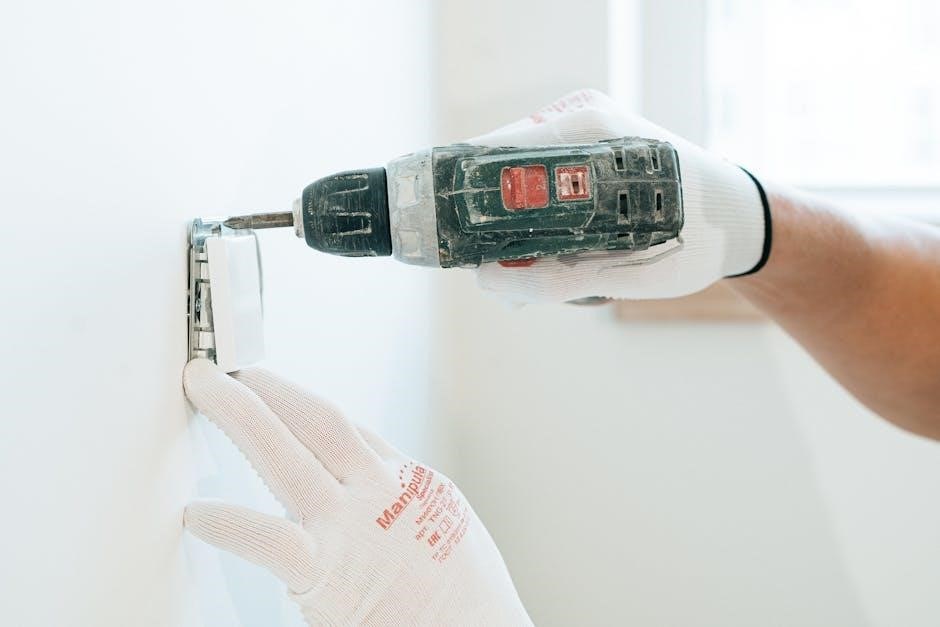Biofinity Multifocal contact lenses by CooperVision are designed to address presbyopia, offering clear vision at all distances․ With Balanced Progressive Technology, they provide a seamless transition between near, intermediate, and far vision, ensuring sharp focus and comfort for wearers․

Key Features and Benefits
Biofinity Multifocal contact lenses are renowned for their innovative design and patient-centric benefits․ Featuring CooperVision’s Balanced Progressive Technology, these lenses provide sharp, clear vision at all distances—near, intermediate, and far—ensuring a seamless visual experience․ They are available in two distinct optical designs (D and N), allowing for personalized fitting to meet individual needs․ Made from the breathable Comfilcon A material, Biofinity Multifocal lenses maintain high moisture levels, promoting comfort and reducing dryness throughout the day․ Additionally, they offer UV protection to safeguard eyes from harmful sunlight․ The lenses’ high water content of 48% ensures long-lasting hydration, while their thin design enhances oxygen permeability for healthy corneas․ With a focus on adaptability and clarity, Biofinity Multifocal lenses are an excellent choice for presbyopic patients seeking a natural, comfortable wearing experience without compromising on visual acuity․

The Fitting Process
The fitting process begins with determining eye dominance and selecting lenses based on patient needs․ A trial period allows patients to adapt, followed by follow-up visits to refine the fit․
3․1 Initial Assessment and Consultation
An initial assessment involves evaluating the patient’s refractive error, ocular health, and lifestyle needs․ The eye care professional uses the CooperVision OptiExpert app to guide the fitting process, ensuring personalized lens selection․ Determining eye dominance is crucial, often using the 1․50 blur-out method․ This step helps identify the dominant eye, which influences how the multifocal lenses are prescribed․ The consultation also includes discussing realistic expectations and addressing any concerns the patient may have about multifocal lenses․ A thorough understanding of the patient’s daily activities and visual demands helps tailor the fitting process for optimal results․ This personalized approach ensures that Biofinity Multifocal lenses are correctly matched to the patient’s specific needs, enhancing comfort and visual clarity․
3․2 Lens Selection and Trial
Lens selection begins with the CooperVision OptiExpert app, which streamlines the fitting process by analyzing patient data and recommending the most suitable Biofinity Multifocal lenses․ The app considers the patient’s refractive error, add power, and eye dominance to suggest an initial lens․ During the trial, the patient is fitted with the recommended lenses, and the fit is assessed after a 15-minute adaptation period․ This allows the lenses to equilibrate and ensures accurate vision assessment․ The trial phase is critical for verifying comfort and visual clarity at all distances․ Adjustments may be made based on patient feedback, such as tweaking the add power or switching between optical designs (D or N) for better performance․ The goal is to achieve a balance between near, intermediate, and far vision, ensuring the lenses meet the patient’s lifestyle needs and visual expectations․

Understanding Biofinity Multifocal Parameters
Biofinity Multifocal lenses are designed with specific parameters to ensure optimal performance for presbyopic patients․ The lenses are made from Comfilcon A, a silicone hydrogel material, offering 48% water content for excellent comfort and breathability․ The aspheric lens design minimizes spherical aberrations, providing crisp, clear vision across all distances․ Available in diameters of 8․6mm and base curves suited for most eyes, Biofinity Multifocal lenses cater to a wide range of refractive needs․ The lenses are available with add powers from +1․00 to +3․00D, allowing customization for varying degrees of presbyopia․ The balanced progressive technology ensures a smooth transition between near, intermediate, and far vision, making it easier for patients to adapt․ Understanding these parameters is key to selecting the right lens for each patient, ensuring both comfort and visual clarity․
Clinical Fitting Steps
Determine eye dominance, use the CooperVision OptiExpert app, and allow 15 minutes for adaptation․ Improve distance vision by adding -0․25D to the dominant eye․ Follow-up visits ensure optimal clarity and comfort․
5․1 Lens Insertion and Initial Fit
Proper lens insertion is crucial for a successful fit․ Train patients on correct insertion techniques to ensure comfort and proper positioning․ Allow the lenses to equilibrate for at least 15 minutes before assessing vision․ Use the CooperVision OptiExpert app for precise fitting guidance․ Assess centration, movement, and tear exchange to ensure optimal fit․ Evaluate visual acuity at all distances to confirm clarity․ If needed, adjust the prescription or lens design to address any visual discrepancies․ Initial fit should prioritize comfort and clear vision, laying the foundation for a smooth adaptation period․ Proper alignment and fit are key to minimizing adaptation time and maximizing patient satisfaction․ This step sets the stage for the wearer’s ability to adapt to the multifocal design effectively․
5․2 Adaptation Period and Vision Assessment
Following lens insertion, allow patients to adapt to Biofinity Multifocal lenses for a minimum of 15 minutes․ This period enables the eyes to adjust to the multifocal design․ Assess visual acuity at near, intermediate, and far distances to ensure clarity and comfort․ If vision is blurry, consider adjusting the prescription or lens parameters․ Use the CooperVision OptiExpert app for guidance on fine-tuning the fit․ Monitor centration and movement to ensure optimal lens performance․ Address any patient concerns, such as halos or glare, by explaining the adaptation process․ Document findings for follow-up visits․ Patients may need time to adapt to the multifocal design, but most achieve clear vision across all distances․ This assessment is critical for confirming the success of the initial fit and making necessary adjustments for long-term satisfaction;
5․3 Follow-Up Visits and Adjustments
Follow-up visits are essential to ensure optimal performance and patient satisfaction with Biofinity Multifocal lenses․ Schedule the first follow-up within 1-2 weeks after the initial fit to assess adaptation and address any concerns․ Monitor visual acuity at all distances and evaluate lens centration, movement, and comfort․ Use the CooperVision OptiExpert app to refine the fit if necessary․ For patients reporting blurry vision, consider adjusting the power in the dominant eye by -0․25D to enhance distance clarity․ Address any issues like halos or glare by reviewing proper care and handling․ Communicate with patients about their adaptation progress, emphasizing that some may need more time to fully adjust․ Document all findings and adjustments for future reference․ Additional follow-ups may be needed to ensure long-term success and make any further refinements to the fit․

Troubleshooting Common Fitting Issues
Common fitting issues with Biofinity Multifocal lenses include blurry vision, halos, and discomfort․ Evaluate lens centration and movement to ensure proper fit․ For patients experiencing blurry vision, check the power and design, and consider adjusting the dominant eye by -0․25D․ Halos may indicate improper centration or dryness; recommend lubricating drops․ If discomfort persists, ensure lenses are clean and consider alternative care solutions․ Address adaptation challenges by allowing sufficient time for the brain to adjust․ For patients struggling with intermediate vision, verify the optical design and consider refining the fit using the CooperVision OptiExpert app․ Document all issues and adjustments for future reference, ensuring optimal visual outcomes and patient satisfaction․
The Role of Technology in Fitting Biofinity Multifocal
Technology plays a pivotal role in the successful fitting of Biofinity Multifocal lenses․ CooperVision’s OptiExpert app is a key tool, providing step-by-step guidance to streamline the fitting process․ It offers personalized recommendations based on patient data, ensuring precise lens selection․ Digital tools like corneal topography and pupil size measurements enhance accuracy, while visual simulators help patients understand expected outcomes․ Additionally, electronic health records (EHRs) enable seamless documentation and tracking of fitting progress․ These advancements not only improve efficiency but also enhance patient satisfaction by tailoring the fitting experience to individual needs․ By integrating technology, practitioners can achieve optimal results, making the Biofinity Multifocal fitting process both effective and patient-centric․

